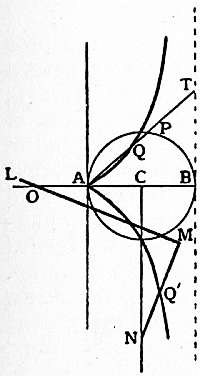Cissoid (from the Gr. κισσός, ivy, and εἰδος, form), a
curve invented by the Greek mathematician Diocles about
180 B.C., for the purpose of constructing two mean proportionals
between two given lines, and in order to solve the problem of
duplicating the cube. It was further investigated by John Wallis,
Christiaan Huygens (who determined the length of any arc in
1657), and Pierre de Fermat (who evaluated the area between
the curve and its asymptote in 1661). It is constructed in the
following manner. Let APB be a semicircle, BT the tangent
at B, and APT a line cutting the circle in P and BT at T; take
 a point Q on AT so that AQ always equals
PT; then the locus of Q is the cissoid.
Sir Isaac Newton devised the following
mechanical construction. Take a rod LMN
bent at right angles at M, such that
MN = AB; let the leg LM always pass
through a fixed point O on AB produced
such that OA = CA, where C is the middle
point of AB, and cause N to travel along
the line perpendicular to AB at C; then
the midpoint of MN traces the cissoid.
The curve is symmetrical about the axis
of x, and consists of two infinite branches
asymptotic to the line BT and forming a
cusp at the origin. The cartesian equation,
when A is the origin and AB = 2a, is
y²(2a - x) = x³; the polar equation is r = 2a sin θ tan θ. The
cissoid is the first positive pedal of the parabola y² + 8ax = 0
for the vertex, and the inverse of the parabola y² = 8ax, the
vertex being the centre of inversion, and the semi-latus rectum
the constant of inversion. The area between the curve and its
asymptote is 3πa², i.e. three times the area of the generating
circle.
a point Q on AT so that AQ always equals
PT; then the locus of Q is the cissoid.
Sir Isaac Newton devised the following
mechanical construction. Take a rod LMN
bent at right angles at M, such that
MN = AB; let the leg LM always pass
through a fixed point O on AB produced
such that OA = CA, where C is the middle
point of AB, and cause N to travel along
the line perpendicular to AB at C; then
the midpoint of MN traces the cissoid.
The curve is symmetrical about the axis
of x, and consists of two infinite branches
asymptotic to the line BT and forming a
cusp at the origin. The cartesian equation,
when A is the origin and AB = 2a, is
y²(2a - x) = x³; the polar equation is r = 2a sin θ tan θ. The
cissoid is the first positive pedal of the parabola y² + 8ax = 0
for the vertex, and the inverse of the parabola y² = 8ax, the
vertex being the centre of inversion, and the semi-latus rectum
the constant of inversion. The area between the curve and its
asymptote is 3πa², i.e. three times the area of the generating
circle.
The term cissoid has been given in modern times to curves generated in similar manner from other figures than the circle, and the form described above is distinguished as the cissoid of Diocles.
A cissoid angle is the angle included between the concave sides of two intersecting curves; the convex sides include the sistroid angle.
See John Wallis, Collected Works, vol. i.; T.H. Eagles, Plane Curves (1885).